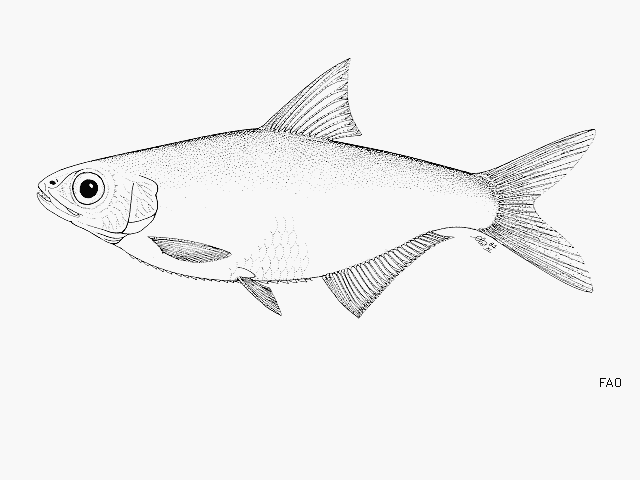|
Dorsal spines (total): 0-0; Dorsal soft rays (total): 11-14; Anal spines: 0-0; Anal soft rays: 22-27; Vertebrae: 37-41. Diagnosis: Body rather deep, its depth about 30-37% of standard length; scutes strongly keeled, 1 or 3 before base of first pectoral fin ray, 13-16 pre-pelvic and 3-7 post-pelvic scutes; snout fairly pointed; lower jaw not or slightly projecting, included in upper when mouth closed, with small teeth limited to anterior part; pre-maxilla with medial notch and 16-26 small conical teeth directed outwards; maxilla blade slender, more than 3 times as long as deep, upper edge with a ridge flared outward; posterior supra-maxilla small, spatulate, shaft as long as or longer than blade; lower gillrakers 14-17 (Ref. 188, 47399). Also characterized by 34-41 scales in a longitudinal series and anal fin with 22-27 rays (Ref. 188, 47399). It resembles Microthrissa minuta, which has more lower gillrakers but fewer anal fin rays, 18-22 and 18-21 respectively (Ref. 188, 47399). It is distinguished from Microthrissa whiteheadi by the presence of a medial notch in pre-maxilla and a lower number of teeth on the pre-maxilla, 16-26 vs. 32-40 (Ref. 46514).
Description: Depth of body 3-3.5 times in total length, length of head 3.5-4 times in total length (Ref. 1878). Snout rounded, shorter than diameter of eye, which is 2.3-3.3 times in length of head and a little greater than interorbital width (Ref. 1878, 41594). Lower jaw not or slightly projecting; maxillary rather narrow, extending scarcely beyond anterior border of eye; premaxilla with 16-26 conical teeth directed outward; maxillary with 8-30 small conical teeth (Ref. 28136, 47399). Gillrakers long and slender, about 14-17 on lower part of anterior arch, 20-36 total gillrakers (Ref. 188, 1878, 47399). Dorsal fin base slightly behind origin of pelvic fins, last ray above first of anal fin, longest ray 4/5 length of head; dorsal fin rays 11-14; anal fin rays 22-27; pectoral fin rays 12-15, pectoral fin rather more than 2/3 length of head, nearly reaching ventral; pelvic fin rays 8; caudal deeply forked, with pointed lobes (Ref. 188, 1878, 47399). Caudal peduncle nearly as long as deep, its depth 10-12% of standard length (Ref. 1878, 93833). Cycloid scales; 34-41 scales in longitudinal series; 12 in transverse series (Ref. 188, 1878, 47399). Scutes strongly keeled; 13-16 prepelvic scutes,with 1-3 scutes before base of pectoral fin, first 3-4 scutes without ascending arms; 3-7 postpelvic scutes (Ref. 188, 1878, 47399, 93833). Number of vertebrae 37-41; with 17-19 abdominal vertebrae and 21-23 caudal vertebrae (Ref. 47399).
Colouration: Preserved colouration brownish, with a rather indistinct silvery lateral band (Ref. 1878, 47399). |
